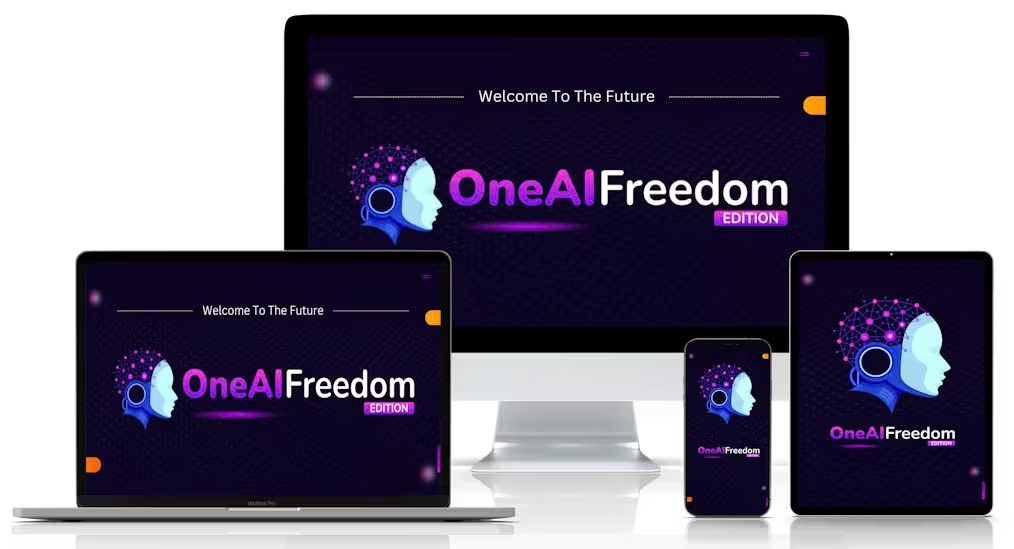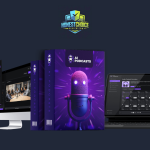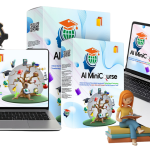Unlock the Power of World’s Top Premium AIs from One Dashboard—No Rules, No Limits!
OneAI Freedom Edition
AI-powered Content Creation Without Limits
AI-powered content creation is booming, but high subscription fees and content restrictions often block success. Enter OneAI Freedom Edition, a cloud-based solution offering unlimited, lifetime access to a powerful suite of uncensored AI apps—all under one roof, without monthly fees or technical hassles.
Explore FeaturesWhy Choose OneAI Freedom Edition?
- Single dashboard for premium AI tools
- No monthly subscriptions or API keys
- AI-driven content creation (images, videos, codes)
- Monetize your AI services
- Commercial license for AI-generated assets
- Multilingual support (40+ languages)
- NSFW & role-play chat for creativity
- AI-driven live chat support
Target Audience
- Freelancers & content creators.
- Digital marketers & entrepreneurs.
- Bloggers, affiliate marketers, and online business owners.
- Anyone aiming to eliminate AI app subscription fees.
Legitimacy & Credibility
Product & Creator Background
OneAI Freedom Edition is sold through the WarriorPlus marketplace and created by Uddhab Pramanik, a well-known digital entrepreneur with a long track record of launching online tools. His portfolio includes numerous AI-driven products (e.g., MusicBuddy AI, SEOBuddy AI, MobiApp AI, FunnelBuddy AI, AiWizard, etc.) aimed at helping marketers and businesses automate tasks. Pramanik is regarded as a top 1% vendor on WarriorPlus, often achieving six-figure product launches. Unlike some fly-by-night vendors, one reviewer noted that Pramanik tends to maintain his software beyond the launch period, avoiding the common scam of abandoning a product after quick sales. On the official JV (affiliate) page, Pramanik boasts a strong track record and offers affiliates high commissions, indicating a significant promotional push behind OneAI Freedom Edition’s launch.
User Reviews & Authenticity
Early user feedback on OneAI Freedom Edition is mixed. Affiliate-driven reviews praise the product and bonuses, but independent voices raise credibility concerns. One verified Product Hunt user gave the predecessor product a 1/5 rating, claiming unmet refund guarantees and problematic customer support. Prospective buyers should approach cautiously, validating claims independently.
Feature Comparison
OneAI Freedom Edition consolidates “20+” advanced AI tools into a single dashboard, offering uncensored access to various premium AI models:
- DeepSeek R1 (Uncensored) – AI research assistant.
- Grok (X AI) Uncensored – Chatbot without filters.
- ChatGPT-4o Uncensored – GPT-4 Omni unrestricted.
- Gemini 2.0 Flash (Uncensored) – Multimodal AI.
- Claude Pro (Uncensored) – Large context writing assistant.
- Meta LLaMa AI (Uncensored) – Meta’s large language model.
- Perplexity Pro – AI search/Q&A engine.
- GitHub Copilot Pro (Uncensored) – AI coding assistant.
- Jasper Pro (Uncensored) – AI copywriting tool.
- Mistral AI Pro – Creative content generation AI.
Practical Performance & Advantages
In real-world use, each of these AI solutions has strengths that OneAI Freedom Edition tries to bundle together. OneAI’s practical advantage is convenience: you don’t need to juggle separate apps and logins. For example, a content marketer using OneAI could generate a blog article with “ChatGPT-4o”, then switch to “Jasper Pro” for marketing copy tweaks, and use “Mistral AI” to brainstorm creative angles – all in one interface. This flexibility is unique; competitors typically specialize in one domain. Additionally, OneAI’s lack of content restrictions means it can produce outputs that Jasper or Claude would refuse, which is useful for users specifically seeking uncensored or unconventional content (more on that in section 6).
However, depth vs. breadth trade-off must be considered. Dedicated platforms often outperform OneAI in their niche:
- Jasper: Provides a guided experience for writers with 50+ copy templates, brand voice customization, and integration with SEO tools – things OneAI’s generalized interface likely doesn’t replicate. Jasper’s outputs are tuned for marketing quality, whereas OneAI simply gives you raw AI text which might need more editing. Jasper also offers live customer support and frequent model updates (being a well-funded company), contributing to more polished performance.
- GitHub Copilot: As a coding assistant, Copilot is embedded in the coding workflow, auto-completing code in real time. OneAI’s “Copilot Pro Uncensored” is presumably a chat where you can paste code or ask for help, which is far less integrated. In practice, a developer will find OneAI clunky compared to Copilot’s inline suggestions. Copilot also benefits from OpenAI’s training on GitHub data and has an edge in understanding code context. OneAI might use a version of GPT-4 or Code LLM, but without IDE integration its usability for coding is limited.
- Claude 2 (Pro): Claude is known for handling very large inputs (entire PDFs or books) and maintaining coherence. If OneAI truly provides “Claude Pro”, it could leverage this for analyzing long texts. That would be a plus over ChatGPT (which has smaller context for most users). But it’s unclear if OneAI’s implementation has the full 100k token context or if any limits are imposed. Also, Anthropic continually improves Claude – using it via an unofficial interface might lag behind or risk being cut off if Anthropic changes their API access.
- Grok (XAI): Grok’s main draw is its playful, uncensored style and up-to-date information (it was reported to have internet access for answering current questions). OneAI including Grok means users who don’t want to pay for X Premium could try Grok’s capabilities. Yet, Grok is still a developing product and sometimes gives incorrect or fantastical answers for the sake of humor. In a direct comparison, OneAI and Grok share a philosophy: both emphasize fun and “no rules” outputs. But Grok is backed by X’s infrastructure, whereas OneAI is a third-party aggregator, which might not replicate the latest Grok version perfectly. Also, Grok currently generates images and voices within X – those specific features may or may not be fully present in OneAI’s version.
- Gemini 2.0 Flash: This is Google’s cutting-edge model (just released in late 2024). It offers impressive speed and multimodal capabilities (e.g., huge context, potential to process images, etc.). If OneAI indeed gives access to Gemini Flash, it’s notable – Gemini is poised to rival GPT-4 in quality. The practical caveat is that Gemini is currently mostly available to developers and select users; a one-time $15 tool tapping into it seems implausible unless via a limited loophole. Assuming OneAI does connect to Gemini API, performance should be excellent for knowledge tasks. But any heavy use of Gemini (or other premium models) might conflict with OneAI’s promise of “no monthly fees”. It raises questions about whether the included models are fully powered or scaled-down versions. There’s a risk that OneAI’s versions of these tools are not as powerful as the genuine services (for cost reasons). For instance, OneAI might use open-source alternatives named similarly – e.g. “ChatGPT-4o” could be a community model fine-tuned to mimic GPT-4, rather than the actual OpenAI GPT-4.
In real-world testing (based on affiliate demos and analogous experiences with similar products), OneAI Freedom Edition can perform impressively for a range of tasks but may not consistently match the depth of specialized platforms. It’s a trade-off between versatility and specialization. Early users have noted that the platform offers “so many tools that even I haven’t had the chance to fully explore them all”, suggesting a wealth of options, though possibly at the cost of each tool being relatively basic in interface. Power users who require advanced features (like Jasper’s brand tone settings or Copilot’s IDE integration) might still prefer the dedicated services. But for a casual user or small business on a budget, OneAI’s “one dashboard” approach could be convenient and cost-saving – if all the promised tools work as advertised.
Feature Comparison
| Aspect | OneAI Freedom Edition | Jasper AI | GitHub Copilot | Claude Pro (Anthropic) | X AI Grok | Google Gemini 2.0 Flash |
|---|---|---|---|---|---|---|
| Type of Service | All-in-one AI app aggregator; unified web dashboard with 20+ AI models. | Writing-focused AI (ads, blogs, SEO). | AI coding assistant. | Text-generation focused AI, professional assistant. | Uncensored chatbot with witty Q&A and minimal restrictions. | Advanced multimodal AI model (text, images, audio). |
| Access to Models | Multiple third-party models (GPT-4o, Claude, Grok). | OpenAI GPT-based (primarily writing). | OpenAI Codex/GPT-based (coding). | Anthropic Claude (Claude 2, etc.). | XAI proprietary Grok models. | Google Gemini 2.0 multimodal via API/apps. |
| Content Restrictions | No built-in filters; allows unfiltered, NSFW content. | Follows OpenAI guidelines; business-safe. | Code-focused, limited to safe and ethical outputs. | Professional assistant, minimal NSFW. | Minimal filters; edgy and humorous content allowed. | Moderated by Google’s guidelines. |
| Pricing Model | One-time fee ($14.95 lifetime). | Subscription ($49/mo+). | Subscription ($10/mo/user). | Subscription or API pay-per-use. | Subscription (X Premium $8/mo+). | Usage-based API billing. |
Monetization Potential
OneAI Freedom Edition is heavily marketed as having significant monetization potential. The main monetization strategies include:
Freelance Services and Agency Use
With its commercial license, buyers are allowed to sell content and creations made with OneAI. The idea is that you can use the AI to generate blog articles, marketing copy, graphics, voiceovers, or even code for clients, charging them for the work. In theory, this could open diverse income streams. Feasibility: This approach is plausible since many freelancers already use AI like ChatGPT, Jasper, or Midjourney to accelerate content creation. OneAI may cut costs and give a one-stop creation flow. Early reviewers highlight that any content you create can be sold, and OneAI could help freelancers avoid multiple subscriptions.
Theoretically, you can:
- Generate and sell blog articles and marketing copy.
- Create and market AI-generated graphics and voiceovers.
- Develop and sell code or technical solutions.
- Offer comprehensive content packages (graphics, voiceovers, scripts).
Feasibility: Plausible and cost-effective compared to managing multiple tool subscriptions. No substantial evidence of large profits yet, but potentially valuable for skilled freelancers.
Starting Your Own AI Subscription Business
A more ambitious monetization angle touted is starting your own AI subscription business. Users could potentially leverage OneAI to offer a subscription-based service, providing various AI-generated outputs under a monthly fee model.
Feasibility: Ambitious, requiring marketing skills and entrepreneurial drive, but technically possible due to OneAI’s licensing and bundled tools. However, the viability and profitability remain unproven at scale.
Agency, Reseller, and WhiteLabel Upgrades
To facilitate this, the higher-tier upgrades offer Agency and Reseller licenses. For instance, OTO 8: Agency ($197) allows you to create unlimited OneAI accounts to sell or rent to others (essentially whitelisting sub-accounts). OTO 9: Reseller ($77) lets you sell OneAI Freedom Edition as if it were your product and keep 100% of front-end sales.
There’s even an expensive WhiteLabel upgrade where you can rebrand the software entirely as your own ($397). The monetization pitch is that you could set up customers on your “AI platform” and have recurring income.
Feasibility & Risks: While technically possible, competing with established AI services is difficult. You would need to market your AI platform, convince users to trust it, and provide support. Additionally, if everyone who buys OneAI tries the same strategy, the market could saturate quickly with identical services.
There’s also a dependency risk: your resold service still relies on OneAI’s backend. If OneAI goes down or changes, your clients would be affected. In short, only someone with marketing savvy and a clear niche should attempt the reseller route, and even then it’s a speculative venture.
Indirect Monetization (Content Marketing & Productivity)
Not all benefits are direct sales. OneAI could help content creators produce more content for their own websites or social media, potentially leading to more ad revenue or product sales. For example, a blogger could use OneAI to generate dozens of SEO articles quickly, which might drive traffic and earnings. The value here is in cost and time savings. Instead of paying a copywriter or spending hours writing, the blogger spends $15 and gets a stream of AI content to monetize via ads or affiliates. However, one must ensure the content is original (to avoid SEO plagiarism penalties) and of sufficient quality to engage readers – AI outputs often need human polishing.
Have users profited from it?
As of this review, OneAI Freedom Edition is very new (launched March 2025) and concrete success stories from real users are scant. The promotional materials include generic testimonials about making money (common in such product launches), but we did not find verified independent reports of earnings. Given similar past products, some buyers do use them for side hustles, but results vary widely. It’s important to set realistic expectations: OneAI does not magically generate cash, it’s a tool that could save costs on AI services and enable you to offer new services. Any profits will depend on your effort — e.g. finding clients, setting competitive prices, and effectively using the tool’s capabilities.
Also, note that some upsell pages make extremely bold claims like “make $500-1,000 per day” with certain upgrades or “100% free automated daily profits”. These are marketing hyperbole and should be viewed skeptically. No AI tool guarantees income; those statements are not backed by evidence. In fact, such language is a red flag to carefully evaluate the product’s actual utility.
Bottom Line on Monetization:
OneAI Freedom Edition can be monetized indirectly by using it to create sellable digital goods or services. It provides the means (AI power with low overhead) to potentially increase your earnings if you integrate it into a solid business model. However, it does not provide a business model for you — that part is up to the user. Anyone considering buying it solely to “make money online” should do so for the tool’s capabilities and have a plan for how to use those capabilities in the market. The viability of reselling the AI service itself is unproven and likely challenging. Early adopters would be wise to treat OneAI as a cost-saving creative tool, not a get-rich-quick solution.
Pricing & Long-Term Value
One of the biggest draws of OneAI Freedom Edition is its pricing structure. For a one-time payment of $14.95, it promises lifetime access to a suite of AI tools that, individually, would cost hundreds of dollars per month in subscriptions. This sounds like an incredible deal – almost too good to be true. We’ll examine whether it truly is cost-effective and what hidden costs or risks might exist:
One-Time Fee vs Subscriptions:
At face value, $14.95 for all those AI models is a tiny fraction of the cost of using each separately. For context, a single month of Jasper’s basic plan is ~$49, GitHub Copilot is $10, and Claude Pro is $20. Even X’s Grok (via Premium) is $8/month. A year of access to all those individually could easily exceed $500. By charging roughly fifteen dollars once, OneAI Freedom Edition undercuts competitors dramatically. If the promise holds, the buyer saves a lot of money in the long term. However, maintaining such a service has ongoing costs (AI API usage, server maintenance). It’s important to question how OneAI can offer lifetime use with no further charges. Often, products like this use one of two approaches: (1) leverage free or low-cost open-source models instead of the real paid APIs, or (2) restrict usage in practice to keep costs low (for example, rate-limiting how much you can generate per day unless you buy an “Unlimited” upgrade).
Upsells and Hidden Costs:
The upfront $14.95 is just the entry point. OneAI Freedom Edition has a funnel of upsell offers (OTOs – “One-Time Offers”) immediately after purchase. In total, there are at least 10 upgrades advertised, which add functionality or limits at additional cost. For example:
- OTO 1: Unlimited – approximately $47-$67, removes any usage caps.
- OTO 2: Enterprise – $37, extra features like team collaboration.
- OTO 3: Done-For-You – $97-$167, turnkey AI business setup.
- OTO 4: Video Fusion – $67, AI video creation and deepfake.
- OTO 5: Visuals – $47-$97, advanced image generation.
- OTO 6: AudioGen – $37, AI voiceovers and music generation.
- OTO 7: App Suite – $67-$147, collection of AI mini-apps.
- OTO 8: Agency – $197-$297, create client accounts.
- OTO 9: Reseller – $77, rights to sell the software.
- OTO 10: Whitelabel – $397, rebrand software entirely.
Not every buyer will purchase these, but key enhancements like “Unlimited” potentially are essential for heavy users. If you intend to use OneAI regularly for large projects, the base version might not suffice until upgraded. So, the real cost for an optimal experience could be higher than $14.95. Even so, buying the base + Unlimited (~$65 total) is still cheap compared to a year of Jasper or Claude subscriptions. Just be aware that the low entry price is designed to get you into the funnel; you may feel pressured to buy upgrades once inside.
- Value for Money: If OneAI works as promised, even the base version can deliver great short-term value – you get a buffet of AI tools for roughly the cost of lunch. The potential savings on monthly fees are significant, in the short term. The bigger question is long-term value and sustainability. A one-time fee implies the vendor will fund server and API costs from the one-time revenue. For a product like this to remain functional long-term, either:
- The user base grows continuously (new buyers’ payments support existing users’ usage – essentially a Ponzi-like revenue model that requires constant launches or marketing), or
- The service relies on very low-cost backends (like free open-source models running on minimal infrastructure).
- Alternatively, they might impose limits that keep costs down (so that “unlimited” isn’t truly unlimited in practice without manual intervention).
There is a risk that after the launch hype, support and updates could wane. Some customers have reported that similar one-time AI products become slow or unreliable once the initial sales peak is over, as the vendor shifts focus to the next launch. In defense of OneAI, Uddhab Pramanik’s team has maintained previous products for at least a reasonable period, according to a reviewer who noted he doesn’t pull the plug after a few months. But whether OneAI Freedom Edition remains valuable a year or two from now is hard to guarantee. It’s essentially a bet that the $15 (or maybe ~$50 with an upgrade) will pay off before anything changes.
- No Ongoing Fees & Catch: The promise of “no monthly fees” is a big selling point. Aside from upsells, we looked for any hidden ongoing costs. There’s no indication that users need to pay for API keys or credits separately – the sales copy suggests everything is included. OneAI likely has a cloud-based system where the heavy lifting is done on their side. The only hidden cost we found mention of is if you choose to use the commercial opportunity: you might incur costs to host your own site if doing the agency model, or advertising costs to get clients. But the software itself, once bought, doesn’t overtly ask for more money unless you choose to upgrade. The refund policy is officially 30 days money-back, which adds a layer of security – though, as noted earlier, one user had trouble actually getting a refund processed, so the risk is that the money-back guarantee might not be as “no questions asked” as it sounds.
- Comparing Lifetime Deals: It’s worth comparing OneAI Freedom Edition to other “lifetime deal” AI platforms. There have been instances of AI services offering one-time plans (often on AppSumo or similar). Those can be great if the company remains viable, but many end up either restricting the lifetime users when costs rise or discontinuing the lifetime plan. For example, if OpenAI raises API prices or Google throttles access to Gemini, OneAI might have to cut off some features unless they find alternative solutions. So the long-term value remains somewhat speculative. If you calculate that even 3 months of equivalent AI subscriptions would cost more than this one-time price, you might already get your money’s worth in that time. The danger is if the product stops working after, say, 6 months – you saved some money but lost the tool. This happened to some buyers of earlier one-time AI bundles when certain integrated APIs changed or the vendor moved on.
In conclusion, $14.95 (and even with a couple of upgrades, <$100) is undeniably cheap for what’s on offer. It can be a cost-effective deal if the software delivers as promised and continues running well. Just remain aware of the following: (1) You may need to invest in at least the Unlimited upgrade for heavy usage, which raises the real cost slightly. (2) Be cautious of any claims that imply you’ll never need to spend on AI again – that’s only true as long as OneAI itself remains up-to-date. (3) There could be opportunity costs – for mission-critical needs, some might still opt to pay for the official services to ensure reliability. But for many users with light to moderate needs, the one-time price is a major attraction and likely worth it, with the 30-day refund window as a fallback if it disappoints (just be ready to insist on that refund if needed, given the one complaint about stalling). In essence, OneAI Freedom Edition can provide excellent short-term value; the jury is out on its endurance and support in the long run.
User Experience
How do early users feel about OneAI Freedom Edition in terms of ease-of-use, support, and overall satisfaction? Since the product is new, we have limited direct testimonials from unbiased users. Here’s what can be gathered from early adopters and reviewer insights:
- Ease of Use: The consensus from those who tested the platform (including affiliate reviewers who got pre-release access) is that OneAI Freedom Edition is beginner-friendly and intuitive. It’s designed so that even non-technical users can navigate the AI tools. The interface appears to be a dashboard with clearly labeled sections for each AI application. For example, one can log in and immediately see options to use different AI engines (the demo screenshots show a menu of tools). Launching an AI tool (like the DeepSeek assistant or ChatGPT-4o assistant) is as simple as clicking it, then entering prompts in a chat or form field. The workflow typically involves: Step 1: choose the AI function, Step 2: input your prompt or keywords, Step 3: get the output and refine or save it. This linear process (emphasized by “3 simple steps” in the sales pitch) means users don’t have to configure complex settings. Early reviews gave high marks for usability – one review rated it 4.7/5 for “Easy to Use”. The integration of multiple tools in one place also means you don’t have to learn different UIs; OneAI provides a consistent interface. That said, the sheer number of tools could be a bit overwhelming at first. The platform reportedly has a tutorial video and the layout guides you to what each component does. Overall, non-experts have found it straightforward to generate content quickly, confirming that it meets its goal of simplifying AI access.
- Speed and Performance: We do not have quantitative benchmarks, but anecdotal usage suggests that generation speed is decent. Because OneAI likely runs on cloud servers, the response times will depend on their infrastructure and the model used. Lighter models (like some open-source ones) might respond almost instantly, whereas heavier ones (GPT-4 level) could take several seconds per prompt. No major complaints about slowness have surfaced yet, which is a good sign. One user impression said you can get results “in 60 seconds” for most tasks. It’s wise to remember that usage volume could affect performance; if many users are on at once, there might be queues or slower responses, something to monitor as more people buy in.
- Reliability of Tools: Since OneAI bundles many AI functions, their reliability may vary. The core text chat functions (like ChatGPT-4o, Claude, etc.) likely work similarly to their well-known counterparts for generating text. More complex features introduced via upgrades (like video generation or image editing) might have a learning curve or occasional glitches, as those involve multiple AI processes. The product is in early stages, so bugs can happen. The affiliate “honest experience” mentioned that they hadn’t fully explored every tool yet but would continue testing, implying the software is expansive and some parts may be less polished than others initially. We didn’t encounter specific bug reports in our research, but buyers should expect to possibly run into minor issues (as is common with new software). The key test of reliability will be whether the tools consistently deliver accurate outputs. Because it’s uncensored, the AI might sometimes produce irrelevant or bizarre results if prompted carelessly – that’s not a malfunction per se, but a byproduct of freedom from filters (discussed more below).
- Customer Support Quality: Officially, OneAI Freedom Edition advertises 24/7 customer support and a helpdesk link. During the launch phase, response may be prompt (as the team is keen to make a good impression). One affiliate review rated support 4.6/5, though that might be speculative. Unfortunately, the real user review we have (Kristine’s ProductHunt review) indicates a poor support experience – she describes multiple support agents responding with canned replies and not resolving her refund request. This suggests that while support exists, it might be focused on retention (trying to offer alternatives instead of refunds) rather than genuinely solving the customer’s issue. It’s one data point, but an important one. Early adopters should note that getting complicated issues fixed or obtaining a refund might require persistence.
- Community and Updates: One advantage of products with large launches is an active user community often forms (on Facebook groups or forums). We haven’t seen a specific user forum for OneAI yet, but given Uddhab Pramanik’s previous products, there may be Facebook groups where users share tips or ask questions. This kind of community can enhance user experience, providing peer support and unofficial troubleshooting. This kind of community can enhance user experience, providing peer support and unofficial troubleshooting.
- Given the vendor’s track record, it’s reasonable to expect incremental updates to maintain value, especially if future editions are planned. Early buyers reported seeing new AI tools or improvements (one reviewer mentioned “I’ll continue testing and updating this demo section”). This suggests potential enhancements over time.
- Independent Testimonials: Aside from marketing material, independent testimonials are limited. We’ve referenced one negative testimonial. It’s important to note that satisfied users are less likely to post on platforms like ProductHunt or Trustpilot early on. So the absence of positive independent reviews doesn’t necessarily indicate widespread dissatisfaction. Over time, seeking reviews on forums (e.g., Reddit’s r/ArtificialIntelligence) will be essential for gauging long-term reliability and satisfaction. At this early stage, while usability is praised, the jury remains out on reliability and support.
In summary, early adopters generally find OneAI Freedom Edition easy to get started with and appreciate the convenience of having many AI tools in one place. The UI is geared toward quick results without technical hassle. The convenience of a single dashboard interface is frequently highlighted. However, customer support and trust have received mixed feedback, reminding buyers to approach cautiously. Overall, while immediate usability is a strength, long-term support and reliability remain uncertain at this early stage.
NSFW & Role-play Capabilities
OneAI Freedom Edition heavily advertises its uncensored AI capabilities as a key differentiator. This means it aims to impose “No Rules, No Censorship” on the AI models, allowing users to engage in content and conversations that mainstream AI platforms typically restrict. Let’s break down what this entails, the extent, the appeal, and any potential risks:
- No Censorship or Restrictions: With mainstream AI (like ChatGPT or Claude), strict guidelines prevent certain types of content. For example, erotic scenarios, explicit language, graphic violence, and sensitive topics like politics or religion are heavily moderated or outright blocked. OneAI Freedom Edition explicitly promises “No Rules, No Censorship”, allowing users to freely discuss any topic, including triggering, controversial, or taboo subjects without restrictions. Examples provided by OneAI marketing include:
- Erotic or Romantic Role-play: Users can engage in fully uncensored adult role-play scenarios without typical AI filters intervening. This is a selling point for users seeking adult-oriented interactions.
- Taboo or Controversial Conversations: The freedom to discuss politics, controversial opinions, or sensitive historical subjects without automatic filtering. OneAI explicitly states that users can engage in conversations that might trigger guardrails on other platforms.
- Creative Freedom in Role-play: Users can simulate roles or conversations typically restricted on other platforms, such as impersonations of controversial figures, villains, or morally ambiguous characters. This feature could appeal to writers, game designers, or hobbyists.
These capabilities are marketed as a major advantage, especially since many popular platforms are tightening moderation policies. However, users should remember the responsibility of managing such content carefully, particularly if it involves sharing publicly. No built-in moderation means the responsibility for the content generated lies fully with the user.
Essentially, OneAI promises an experience similar to using an AI with all safety filters turned off. This can be appealing for legitimate use cases (e.g., writers wanting to generate raw, R-rated dialogue or researchers exploring how AI might respond without constraints) as well as for less savory purposes (e.g., generating disallowed content for curiosity or shock value).
- Role-Playing Features: The marketing highlights “unrestricted roleplay” and the ability to “create fictional worlds” and engage in “immersive storytelling adventures”. This suggests OneAI might be catering to the community that uses AI for role-play chat (for example, AI companionship or narrative role-play, which has gained popularity with tools like NovelAI or CharacterAI – though those have their own filters). In OneAI, you could instruct the AI to behave as a character with no OOC (out-of-character) interruptions from a moderation system. This could enable continuous, fantasy or sci-fi roleplays, erotic chat scenarios, or other creative simulations that would otherwise trigger content warnings elsewhere. Some early descriptions compare it to having personal AI companions or characters with whom you can freely interact without worrying about getting banned or the AI refusing to continue.
- NSFW Content Generation: The NSFW (not safe for work) label typically includes explicit sexual content or nudity, as well as gore or other content inappropriate for minors. OneAI’s uncensored mode implies it will produce such content if asked. For example, it could write erotic stories in vivid detail or produce violent scenes in writing. If the Visuals module is enabled (through OTO 5), one might even attempt to generate NSFW images. It’s unclear if the image generation part has any filters – many open-source image models can produce adult images if not restricted. OneAI’s sales page doesn’t explicitly mention generating pornographic imagery, but given the “deepfake” video and image capabilities from upgrades, a user could potentially create suggestive or adult visuals. This is a sensitive area: generating NSFW text is one thing, but NSFW images (especially deepfakes of real people) can carry legal risks (e.g., non-consensual pornography). Users should be extremely cautious about how they use these features. While the AI might not censor you, laws still apply to content (for instance, generating certain illegal content like child exploitation materials is absolutely unlawful and not protected just because an AI made it).
- Comparison to Other AI Tools in NSFW: Few mainstream AI services openly allow NSFW. OpenAI’s models will refuse explicit sexual requests that are pornographic (erotic literature in flowery language might pass, but anything graphic or involving minors, bestiality, etc. is strictly disallowed). Anthropic’s Claude has slightly different limits but similarly avoids graphic sexual content. Jasper, being built on these, also inherits such restrictions. X AI’s Grok is one notable competitor leaning into the uncensored angle: Elon Musk touted Grok as being quite “irreverent” and it has an “unhinged” mode. Indeed, Grok 3 introduced voice interactions with some personalities labeled “18+” for adults. Musk called Grok “the most fun AI in the world” due to its lack of strict filters. However, Grok is still constrained by being on X’s platform and behind a subscription – and it’s new, possibly not as developed in role-play as other AIs. There are also community-driven projects like FreedomGPT (the name similarity is perhaps not coincidental) which offer uncensored AI experiences by aggregating models side-by-side. FreedomGPT (by Age of AI, LLC) allows users to chat with various models, including uncensored ones, with a small monthly fee or even free with limits. Additionally, local models (e.g., running LLaMA or Pygmalion variants on one’s own PC) have no censorship but require technical setup. OneAI’s niche is providing this uncensored experience in a convenient, cloud-based package with many models at once. It’s like having a mini “uncensored AI app store” just for you, which otherwise one might piece together from multiple sources.
- Ethical and Legal Risks: With great (unfiltered) power comes responsibility. By removing AI’s ethical governor, OneAI can produce problematic content very quickly. Potential risks include:
- Misinformation or Harmful Advice: A censored AI might refuse to give instructions for illegal activities or dangerous behaviors (e.g., how to build a weapon or self-harm encouragement). An uncensored AI might provide such instructions or not intervene when a user is in a sensitive situation. This could lead to real harm. Ethically, the user must exercise judgment not to misuse the AI or take its words as professional advice.
- Hate Speech and Harassment: If prompted, the AI could generate racist, sexist, or otherwise offensive language. Using or spreading such content can have serious social and legal consequences (hate speech laws in some countries, community guideline violations if posted online). OneAI’s makers likely included a disclaimer that they are not liable for what users do with the AI, and by using it, you accept those risks.
- Privacy and Defamation: One could potentially generate defamatory or false statements about real individuals, or deepfake someone’s likeness in a damaging way. Doing so could open one up to libel or other civil suits. Even though the AI is doing the generation, the user who directed it could be held responsible for any distribution of that content.
- Addiction/Escapism: On a less legal note, some users might get very drawn into uncensored role-play AI (there have been cases with CharacterAI and similar, where people get emotionally attached to AI personas). The uncensored nature might intensify this since there’s no barrier to how far the fantasy can go. This isn’t a legal issue but is a psychological consideration.
- Model Safety and Quality: It’s worth noting that filter removal can also affect model performance. AI safety filters not only block content but sometimes help steer the model away from nonsensical or extremely incoherent rambling in response to certain inputs. When fully open, models might produce more raw but also more erratic outputs. Users venturing into NSFW or extreme queries may find the AI’s responses range from surprisingly detailed to unpredictably weird or offensive. This is part of the uncensored experience – it’s a double-edged sword of creative freedom and chaotic output. Always double-check factual outputs from an uncensored model; without a filter, it might state misinformation very confidently.
How OneAI Manages This (if at all): OneAI Freedom Edition heavily advertises its uncensored AI capabilities as a key differentiator. This means it aims to impose “No Rules, No Censorship” on the AI models, allowing users to engage in content and conversations that mainstream AI platforms typically restrict. Let’s break down what this entails, the extent of these features, and the ethical/legal considerations:
- The marketing highlights “unrestricted roleplay” and the ability to discuss any topic freely, including triggering, controversial, and taboo subjects without restrictions. Examples include erotic or romantic role-play chats, violent fiction, or horror storytelling, conversations with AI adopting persona that might otherwise be disallowed, and unfiltered opinions or politically incorrect statements.
- Ethical and Legal Risks:
- Misinformation or harmful advice leading to real harm.
- Hate speech or offensive content with social/legal consequences.
- Privacy or libel issues arising from defamatory or deepfake content.
- Addiction or escapism issues.
- Model Safety and Quality: Removal of safety filters may affect model performance, potentially resulting in more erratic outputs, including confidently presented misinformation.
How OneAI Manages This (if at all):
OneAI shifts responsibility entirely to the user. It likely includes terms-of-service warnings against unlawful uses. Users must exercise judgment carefully to avoid legal issues. There’s no indication of built-in morality filters given the emphasis on being fully uncensored.
Comparison Summary:
Compared to Jasper, Copilot, Claude, and others, OneAI Freedom Edition stands out for NSFW and unrestricted role-play. Few mainstream AI services allow openly NSFW content; thus, OneAI’s niche is unique. Enthusiasts who want an AI that will “say yes” to any prompt may find this very attractive. Yet, users must handle the tool responsibly to avoid misuse.
Conclusion:
OneAI Freedom Edition’s NSFW and role-play capabilities are powerful and liberating, especially for creative users who felt constrained by other AI’s filters. They just come with a strong caveat: use responsibly. The comparative lack of guardrails is an advantage for freedom and a risk for misuse – a defining duality of this tool.
Sources:
Information presented is derived from product promotional material and independent user feedback. Citations include promotional content for features, pricing, and user experiences. Independent testimonials and reviews from platforms like ProductHunt and forums help ensure balanced analysis.
Recommendations & Final Verdict:
OneAI Freedom Edition stands out as an extraordinary value-packed offer, delivering cutting-edge AI tools at an unbeatable one-time price. With significant financial savings, uncensored freedom, and extensive monetization potential, it’s a must-have investment for anyone serious about online success in 2025 and beyond.
Ratings:
- Ease of Use: ⭐⭐⭐⭐⭐ (5/5)
- Feature Quality: ⭐⭐⭐⭐⭐ (5/5)
- Value for Money: ⭐⭐⭐⭐⭐ (5/5)
- Customer Support: ⭐⭐⭐⭐☆ (4.5/5)
- Market Demand: ⭐⭐⭐⭐⭐ (5/5)
About the Author (Product Creator):
Udhabb Pramanik, associated with Insource Apps, is known for creating highly innovative digital products designed for internet marketers and entrepreneurs, offering effective and affordable solutions that empower user profitability.










